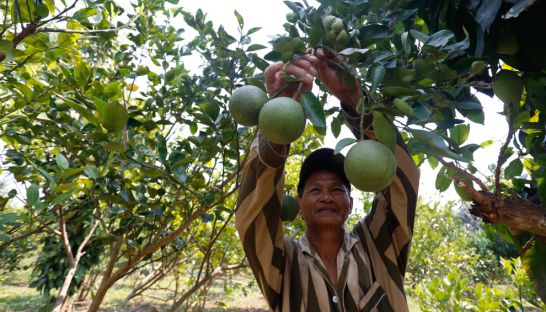Oranges struggle with disease
Oranges struggle with disease
Orange farmer Say Samoeurth has been battling an invisible foe. He rarely sees his adversary, a tiny insect known as the Asian citrus psyllid, but wherever it goes this winged pest leaves behind a trail of destruction.

Most of the 1,000 orange trees that Samoeurth planted on his 2-hectare farm have been affected, with a bacteria transmitted by the sap-sucking insect stunting their growth and causing their leaves to turn colour and fall off. Some of defoliated trees still bear fruit, but its green, mottled appearance and bitter flavour prevents its sale in the market.
Samoeurth, who has been growing oranges on his land since 1996, said he first learned of the link between the psyllid and “citrus greening disease” from government agriculture officials. But no solutions were offered, and their advice was simply to cut down the orchard and plant something else.
Having invested his life savings into his orchard, the 52-year-old citrus farmer is reluctant to give up. Instead, he has sunk more money into his dying farm, uprooting the infected trees and transplanting new ones.
“I tried to invest in new saplings, but now they have become infected too,” he said. “The seller said they were healthy, but I had no way of knowing the origin of these trees, and whether or not they were infected.”
Hor Phuthea, director of horticultural and subsidiary crop department at the Ministry of Agriculture, said there is no cure or vaccine for the citrus greening disease, which has been spreading among Battambang’s prized orange farms since the 1990s. As such, the ministry has advised all affected orange farmers to destroy their orchards and switch to another crop though few have heeded the advice.
“Most of our orange trees are infected with this disease,” he said. “Once infected, the disease kills the orange tree and we found that once the tree approaches maturity in two years there is no way for it to survive. The only option is to cut it down and switch to another crop.”
He added that farmers who cut down the trees and plant new orange trees on the land will suffer re-infection, as the disease remains on the land.
In Sovanmony, director of Battambang’s provincial agriculture department, said citrus greening disease could be a death knell for the province’s famous orange industry. He said the disease was now endemic, and was continually whittling away at yields.
However, last year, the area of orange cultivation decreased marginally by 3 percent to 997 hectares compared to 1,027 hectares in 2015, according to government data. “Orange cultivation is declining and the extent of the damage will be even larger in the future if farmers continue to invest in their orchards without using healthy trees,” he said.
Sovanmony said some small farmers had given up on oranges and switched to other fruit cash crops, such as mangoes and longans. But the high profit potential of oranges – with farmers able to rake in over $20,000 from the harvest of one hectare of healthy trees – had tempted many farmers whose fields were ravaged by citrus greening disease to re-plant oranges.
“We know that it is profitable, but it is not a long-term investment and farmers will face high risk as the disease continues to spread,” he said.
There is hope, however. According to Phuthea, researchers at the Royal University of Agriculture are studying how to identify the disease in its earliest stages and educating farmers to avoid planting contaminated seedlings.
“We informed farmers to switch off of orange growing for a while,” said Phuthea. “Researchers at the Royal University of Agriculture have been studying this issue for many years and I believe they will announce their results to the public soon.”
Mak Samoeurn, a 65-year-old citrus farmer, said the 900 orange trees on his 1.5-hectare orchard in Battambang province’s Sangke district has until now remained free of the disease. He has harvested the five-year-old trees twice already, earning about $5,500 profit per season.
“Of course I’m concerned about the health of my farm,” he said. “I am trying to figure out if any fertiliser or chemicals can protect my trees. I saw other farms were infected by the disease and it damaged the trees.”













